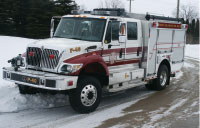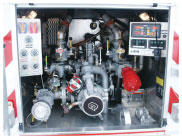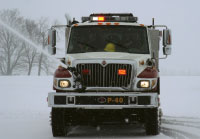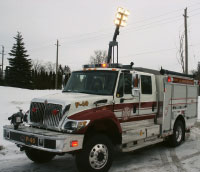
Equipment
Canadian climate, terrain no match for Timberwolf
Multipurpose apparatus meets needs of Ontario department
April 8, 2008
By
Laura King
The new apparatus at the Centre Wellington Fire Rescue in Ontario looks a bit like the vehicles used to carry tourists to see polar bears in the Arctic. It’s compact but with big tires and looks like it can drive through anything Mother Nature throws at it.
 |
 |
| PHOTOS COURTESY CENTRE WELLINGTON FIRE RESCUE The Centre Wellington Fire Rescue received four-wheel drive Rosenbauer Timberwolf apparatus in February, while the province was covered with snow. |
Centre Wellington opted for a high-pressure pump for its Timberwolf, similar to those used in the United Kingdom. The pump operates at 500 psi (3,600 kPa). Running high pressure through smaller lines produces smaller water droplets, which absorb heat faster. |
 |
 |
| The short wheel base and compact design make the Timberwolf more manoeuvrable than other vehicles. | The myriad features on the Timberwolf make it particularly suitable for wildland firefighting. |
That’s exactly what Fire Chief Brad Patton wanted. When a tornado blew through the region northwest of Toronto in 2005, firefighters had trouble manoeuvring their apparatus around the debris. And with the volume of brush fires and extreme weather in the department’s 420-square-kilometre area, Patton was on the prowl for something powerful and affordable that could tolerate the region’s climate and terrain.
“We did a lot of research,” says Patton. “And I certainly agree with all the scientists that we’re in for severe weather swings and that the weather is going to get worse. Quite often in our area the municipality closes roads – five times this year they’ve closed highways and back roads and pulled the snowplows off the streets – so we needed a vehicle that was going to get where we needed to go.”
In addition, Centre Wellington is home to farm country and a Mennonite population that relies on horses and buggies, meaning the snow is rarely cleared from long driveways leading to homes and barns.
When the volunteer department’s 18-year-old aerial came up for retirement in 2005, Patton says officers did a lot of soul searching about whether Centre Wellington needed two aerials. Ultimately, it was determined that mutual aid would be called in if a second aerial became necessary and that the department would order a vehicle to meet its other needs.
In the last 15 years, Centre Wellington’s responses to structural fires have dropped to between three and four per cent of calls from between 15 and 20 per cent, while responses to “other” types of alarms have increased more than 600 per cent.
So, armed with a list of 27 features the department wanted on its new apparatus – including four-wheel drive, a large amount of water, an enclosed cab and suitability for wildland, basic extrication calls and severe weather – Patton wandered the trade-show floor at the Ontario Association of Fire Chiefs convention. After being told by some manufacturers that the list of demands couldn’t possibly be met, Patton came face to face with Rosenbauer Firefighting Technology’s specialty vehicle, the Timberwolf.
Centre Wellington took delivery of its $355,000 (less than half the cost of an aerial) Timberwolf severe-weather apparatus on Feb. 15 – the first Timberwolf in Canada. It was then sent to ResQtech Systems Inc. in Woodstock, Ont., – the Canadian distributor for Rosenbauer – to be fitted with equipment. Every piece of equipment is mounted so that nothing goes awry while navigating rough terrain. The truck is also fitted with items for structural firefighting, water rescue, auto extrication and first aid/trauma.
ResQtech president Brian Innis describes the Timberwolf as an urban interface truck with all the features of a standard pumper plus wildland abilities, a short, manoeuverable wheel base and full-depth storage compartments.
The concept for the Timberwolf came from a Rosenbauer rep in California who saw a need for a more manoeuvrable wildland apparatus.
Innis says some Canadian departments that viewed the Timberwolf thought its short, stocky frame meant it was too small to hold all the necessary firefighting equipment but Centre Wellington’s apparatus disproves that theory.
“With Centre Wellington, they have all their equipment on it and there’s still more space,” he said. “We’re packaging the equipment better so we’re getting smaller vehicles that are much more manoeuvrable.”
After the apparatus arrived in Centre Wellington, firefighters reviewed calls for the previous year and wished they’d had the Timberwolf sooner for responses to brush and grass fires in which they had to leave the pumper at the side of the road and lay hose lines. They’re confident the Timberwolf would have easily traversed the rugged terrain.
The Timberwolf joins a 100-foot E-One aerial, two 2,500-gallon tankers, two heavy rescue units, two 15-foot Zodiacs, one Argo all-terrain vehicle and two pumpers at Centre Wellington’s two stations in Fergus and Elora. There are 25 firefighters in each station, all volunteer, along with a full-time chief, public safety officer and administrative assistant.
Last year, Centre Wellington crews put in 17,405 hours on 560 calls. The department is one of largest volunteer departments in Ontario.
One of the key differences on the custom Timberwolf for Centre Wellington is the high-pressure pump, similar to those used in the United Kingdom.
As in most other centres, Centre Wellington’s pumpers operate at 75 to 100 psi (750 kPa). The Timberwolf front lines operate at 500 psi (3,600 kPa). The consensus among proponents of high-pressure pumps is that running high pressure through smaller lines produces smaller water droplets, which absorb heat faster and therefore knock down fires faster, using less water.
Patton says the high pressure allows for greater penetration when working deep fires and allows firefighters to be further away when fighting vehicle fires.
The Timberwolf pump can also work in the traditional low-pressure mode if necessary.
Rescue vehicles in the Ontario communities of East Gwillimbury, Stratford and Orillia have similar Rosenbauer pumps on their vehicles.
| Centre Wellington Timberwolf
Chassis International 7400 SFA, 4 x 4 4 door, 5 passenger High ground clearance Short wheelbase GVWR 14,968 kg; loaded weight 12,000 kg Engine Pump Generator Price Highlights |
Print this page
Advertisement
- High-tech transportation: New developments make vehicles stronger and challenge rescue personnel
- 10-year-old accused of setting fires